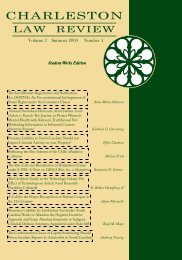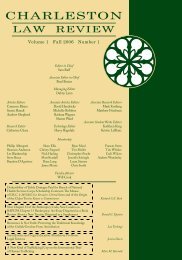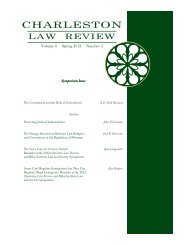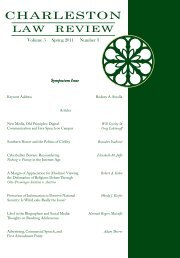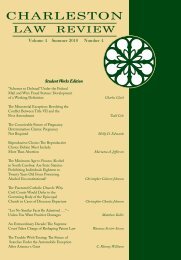Volume 5 Winter 2011 Number 2 - Charleston Law Review
Volume 5 Winter 2011 Number 2 - Charleston Law Review
Volume 5 Winter 2011 Number 2 - Charleston Law Review
You also want an ePaper? Increase the reach of your titles
YUMPU automatically turns print PDFs into web optimized ePapers that Google loves.
CHARLESTON LAW REVIEW [<strong>Volume</strong> 5casebook and Socratic dialogue methods of teaching law mightlimit the ability of students to acquire the necessary skills tofunction in today’s legal environment. 5 Thus, as scholars withinthe legal academy look outside its boundaries for educationtheory and best practices, educational concepts such asmetacognition, 6 transfer of learning, 7 and self-directed learning 8are becoming more commonplace in the legal education lexicon.So, too, is the controversial concept of “learning styles,” whichgenerally speaking has been defined as “those cognitive,affective, and psychological behaviors that indicate how learners5. For example, the fall 2009 edition of Perspectives: Teaching LegalResearch and Writing contains an annotated bibliography on law teaching.Mary Olszewska & Thomas E. Baker, An Annotated Bibliography on <strong>Law</strong>Teaching, 18 PERSP.: TEACHING LEGAL RES. &WRITING 34 (2009); cf. ArturoLópez Torres & Mary Kay Lundwall, Moving Beyond Langdell II: An AnnotatedBibliography of Current Methods for <strong>Law</strong> Teaching, 35 GONZ. L.REV. 1 (2000)(containing extensive bibliography on teaching various subjects of law).6. The theory of metacognition, which comes from the field of educationalpsychology, refers to “the self-monitoring by an individual of his own uniquecognitive processes”; that is, “having both awareness and control over one’slearning and thinking.” Anthony S. Niedwiecki, <strong>Law</strong>yers and Learning: AMetacognitive Approach to Legal Education, 13 WIDENER L. REV. 33, 35 (2006);see also Robin A. Boyle, Employing Active-Learning Techniques andMetacognition in <strong>Law</strong> School: Shifting Energy from Professor to Student, 81 U.DET. MERCY L. REV. 1 (2003); John M. A. DiPippa & Martha M. Peters, The<strong>Law</strong>yering Process: An Example of Metacognition at Its Best, 10 CLINICAL L.REV. 311 (2004); Paul T. Wangerin, Learning Strategies for <strong>Law</strong> Students, 52ALB.L.REV. 471 (1988).7. “Transfer of learning” refers to the extent to which one is able totransfer skills and knowledge from one context to another. SARAH LEBERMAN ETAL., THE TRANSFER OF LEARNING: PARTICIPANTS’ PERSPECTIVES OF ADULTEDUCATION AND TRAINING 1 (2006); Michael Hunter Schwartz, Teaching <strong>Law</strong> byDesign: How Learning Theory and Instructional Design Can Inform and Reform<strong>Law</strong> Teaching, 38 SAN DIEGO L. REV. 347, 366 (2001) [hereinafter Schwartz,Teaching <strong>Law</strong> by Design]. See generally Tonya Kowalski, True North:Navigating for the Transfer of Learning in Legal Education, 34 SEATTLE U. L.REV. (forthcoming 2010); Shirley Lung, The Problem Method: No SimpleSolution, 45 WILLAMETTE L. REV. 723, 740–48 (2009).8. “Self-Regulated Learning . . . is a cycle in which a student activelycontrols her behavior, motivation and thinking process, as she is engaged inacademic tasks.” MICHAEL HUNTER SCHWARTZ, EXPERT LEARNING FOR LAWSTUDENTS 27 (2d ed. 2008) [hereinafter SCHWARTZ, EXPERT LEARNING FOR LAWSTUDENTS]; see also Lung, supra note 7, at 736 (explaining that self-directedstudents “learn to identify gaps in their knowledge within a particular context,to assess their strengths and weaknesses, and to develop, control and adjusttheir own learning agendas accordingly”).136



